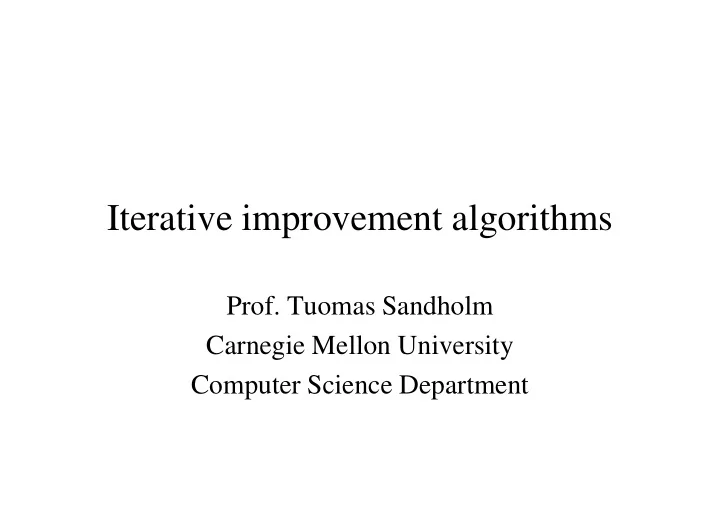

Iterative improvement algorithms Prof. Tuomas Sandholm Carnegie Mellon University Computer Science Department
Iterative improvement algorithms = iterative refinement = local search Usable when the solution are states, not paths. Start with a complete configuration and make Start with a complete configuration and make modifications to improve its quality.
Hill-climbing Search Iterative improvement algorithms try to find peaks on a surface of states where height is defined by the evaluation function
Hill-climbing Search… function HILL-CLIMBING( problem ) returns a solution state inputs : problem , a problem static : current , a node next , a node current � MAKE-NODE(INITIAL-STATE[ problem ]) loop do next � a highest-valued successor of current if VALUE[next] < VALUE[current] then return current current � next end end Best-swap vs. first-swap
Hill-climbing Search… Problems: 1. Local maxima • No progress 2. Plateaux (essentially flat evaluation fn) • Random walk 3. Ridges • Search may oscillate from side to side, making little progress Potential solutions: random restarts • Eventually finds the optimal solution • On NP-complete problems it is likely that there are exponentially many local optima Usually good solutions can be found quickly. Performance depends on the “state-space surface”. How to find feasible neighbors?
E.g. 2-swap in TSP 3-swaps…
Simulated Annealing
Simulated Annealing… function SIMULATED-ANNEALING( problem,schedule ) returns a solution state inputs : problem , a problem schedule , a mapping from time to “temperature” static : current , a node next , a node T , a “temperature” controlling the probability of downward steps current � MAKE-NODE(INITIAL-STATE[ problem ]) for t � 1 to ∞ do T � schedule[ t ] if T =0 then return current if T =0 then return current next � a randomly selected successor of current ∆ E � VALUE[ next ] – VALUE[ current ] if ∆ E > 0 then current � next else current � next only with probability e ∆ E/T Does not always find an optimal solution, and does not know whether it has found an optimal solution. [Theoretical results show that if T is lowered slowly enough (extremely slowly), the optimum will be found]
Heuristic Repair Iterative improvement in CSPs called heuristic repair. Min-conflicts heuristic: choose a value that results in a Min-conflicts heuristic: choose a value that results in a minimum number of conflicts with other variables.
Heuristic Repair (cont.) A two-step solution for an 8-queen problem using min-conflicts. At each stage, a queen is chosen for reassignment in its column. The number of conflicts (in this case, the number of attacking queens) is shown in each square. The algorithm moves the queen to the min- conflict square, breaking ties randomly. Surprisingly effective - 10 6 queens in 50 steps on average - Hubble space telescope scheduling (3 weeks � 10 minutes for scheduling a week of observations)
Recommend
More recommend